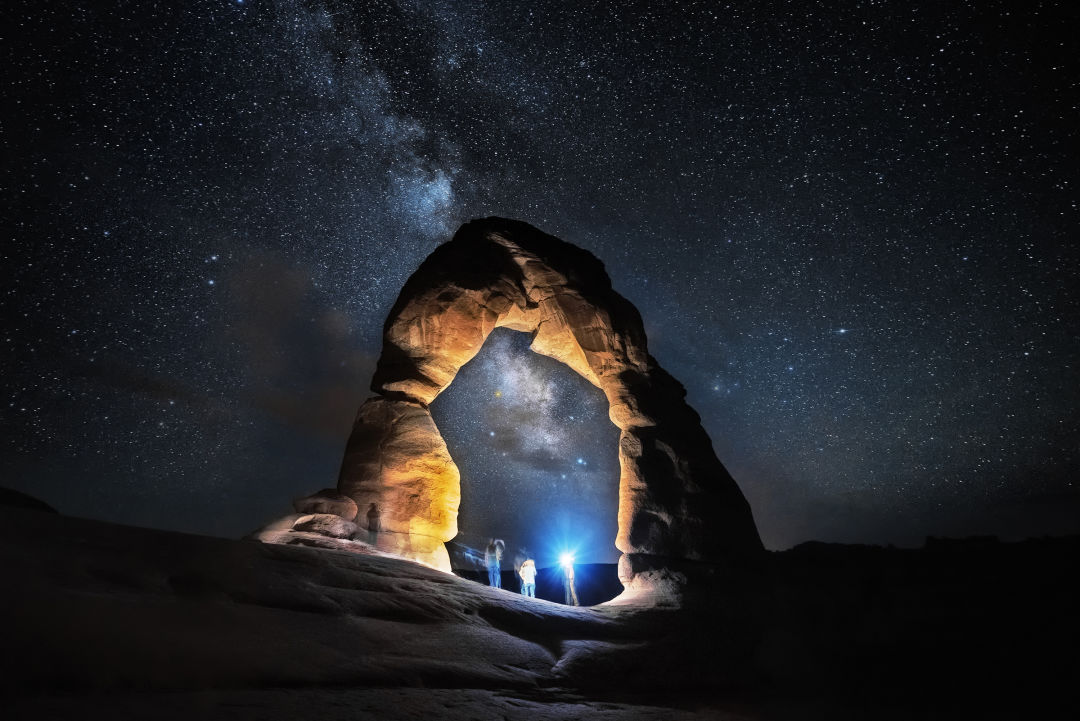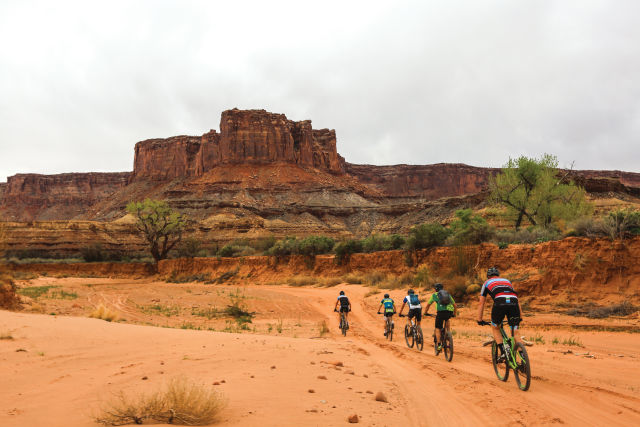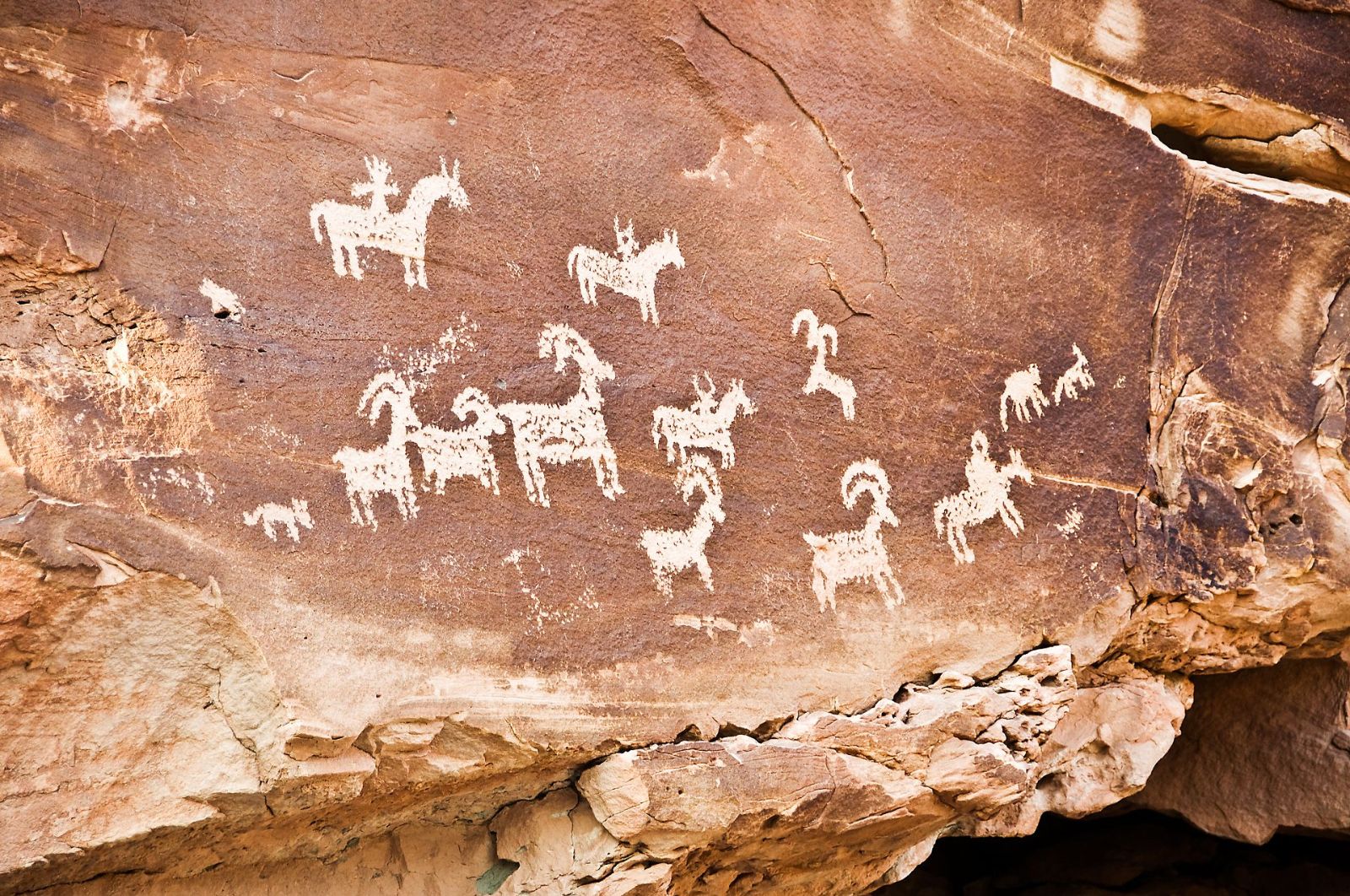THEY’RE KNOWN AS WINDOWS TO THE UNIVERSE. Gateways to the Jurassic. Portals in space and time. Call them what you will, but arches are literal holes in the wall, carved by epochs of wind and water from huge outcroppings of weathered sandstone known as fins. In Arches National Park, you’ll find the largest concentration of them in the world—2,000 and counting. Not surprisingly, tribes native to this region of Utah red rock have long centered arches in a creation story that involves going from one world into the next—and truly, this park just may take you places.
“I’ve been here for two years now, and I have yet to drive into the park and not be blown away,” says Angie Richman, who oversees the Arches visitor center and its interpretive rangers, enlightening guests on all sorts of red rock factoids (did you know, for example, that one of these natural formations must be three feet across to be considered an arch?). “Every time I drive in here, I’m like, ‘This park is so amazing!’”
“This is the most beautiful place in the world,” famed nature writer (and former Arches ranger) Edward Abbey wrote in his renowned narrative Desert Solitaire. You might want to read it before cresting the park’s main entrance, which opens onto a one-way, 18-mile scenic route of jaw-dropping geological wonders, including Balanced Rock, a huge chunk of sandstone sitting atop a crumbly pillar, set among a mesa of dust, juniper, and sagebrush.

Balance Rock
IMAGE: WHITRICHARDSON/ALAMY
You won’t be alone. Nearly 1.5 million tourists visit annually to snap photos and gaze out at the vast horizon—the Sierra La Sal loom in the southeast, Canyonlands National Park beckons from the southwest, and Moab, an outdoorsy oasis, rests in a valley due south. You can’t bike on Arches trails (no pets are allowed, either), but most folks come to hike and bask beneath the sun, moon, and stars.
“The majority of days here are really clear, so you have that beautiful contrast between the sandstone and the blue sky,” says Richman. “No matter where the sun is in the sky, it’s going to be hitting the rocks.” And it’s going to be changing their color—from all shades of taupe to vivid violets—a phenomenon best witnessed at Landscape Arch, the park’s biggest formation at 306 feet across, or the less crowded Double O Arch for sunrise, and at Skyline Arch at dusk, where you can give your legs a break. “That’s really nice,” Richman attests. “It’s pretty much right off the road, and perfectly aligned so that the sunset hits it.”
Of course, the true diva of this rock show is Delicate Arch. “That’s the one that’s on the license plate, and on the billboard in the state of Utah,” says Richman.
Granted, the hike out to it (from Wolfe Ranch) is a strenuous 1.5 miles uphill. For an easier feat, take in the sight of it at Lower Delicate Arch Viewpoint and then try Double Arch in the lower Windows area, for a hike that is about a quarter mile out and pretty flat. And don’t miss the numerous features with exceptionally clever names: Park Avenue, Courthouse Towers, The Fiery Furnace (accessing the latter requires a guide or day permit). Maybe you’ll even find a new arch among the numerous trails. “We’re sure there are some out there we have yet to discover,” Richman says.

Don’t forget to visit Delicate Arch at night.
IMAGE: JUN SU/SHUTTERSTOCK
Whatever the case, don’t forget to gaze at the stars come dark. Arches was certified as an International Dark Sky Park just last year, and at Panorama Point you’ll find benches big enough to lie down on while taking in the abode of the gods. And don’t shy away from doing so, says Richman—“It’s highly encouraged.”
STAY
Reservations for the Devil’s Garden campsite in Arches (nps.gov/arch, $25 per night) go quickly. If you can’t snag one, head over to Moab (discovermoab.com), where you’ll find plenty of commercial campsites with dump stations and amenities, including The Portal (portalrvresort.com, rates vary seasonally) with a pool and spa, fishing pond, dog park, and 58 hook-ups, including Wi-Fi and cable TV. Or shy away from town at pet- and kid-friendly Archview RV Resort, with its own general store, pool, splash pad, trails, around 90 hookups, and, as the name implies, a great view of Arches (sunrvresorts.com, rates vary seasonally).

Devil’s Garden
IMAGE: MILAN RADEMAKERS/SHUTTERSTOCK
DO
Moab is all about mountain biking—start at Chile Pepper Bike Shop for rentals, gear, and trail maps for scenic or difficult outings (chilebikes.com). Nearby Canyonlands National Park (nps.gov/cany) is also a must to visit for White Rim (hello, trail runners) and Island in the Sky. Raft the Moab Daily, a popular 13-mile stretch of the Colorado River that flows right through town, or rent a dune buggy if you want to rock-crawl like the locals (moabadventurecenter.com). Bringing pets? Dead Horse Point State Park has dog-friendly trails and breathtaking views of canyon country, too (stateparks.utah.gov).

Biking on White Rim Trail.
IMAGE: KYLE T. PERRY/SHUTTERSTOCK
EAT/DRINK
Order up a Frito pie and a hand-spun milkshake at Milt’s Stop & Eat (miltsstopandeat.com), a retro fast-food stand that first opened in 1954 but now slings hormone-free grass-fed burgers to avid cyclists and runners. At La Sal House (lasalhouse.com) refined western cuisine goes global with a menu that offers Hatch green chile poutine, house-made naan with labneh, and braised Colorado lamb.
For a more relaxed day trip, head to Castle Creek Winery (castlecreekwinery.com) for a tasting (from noon to 6:30 p.m. every day but Sunday) at the Red Cliffs Lodge, where John Wayne, among others, filmed lots of movies. Today you’ll find a bustling resort with its own film museum—and do stay for dinner at the Cowboy Grill, with a view of the Colorado River and plenty of cuts sourced from the range (redcliffslodge.com.).

Cowboy Grill
IMAGE: COURTESY OF RED CLIFFS LODGE
DON’T MISS
Hop on the Upper Colorado Scenic Byway (U-128), known here as “the river road,” for a 44-mile, awe-inspiring day trip winding along canyons carved out by the river over thousands of years.
You’ll want to pause at the Fisher Towers Viewpoint, for an epic photo-op of the red rock spires and mountain range beyond, and take in the ghost town, Cisco.
For a shorter drive, try State Route 313 West, where one roadside pull-off will land you at a pictograph known as Intestine Man, a painted rendering of a man (right down to the intestines, hence the name) that is believed to be at least 7,000 years old, as well as several ancient petroglyphs carved in the Barrier Canyon style into the rocks.

IMAGE: DELPIXEL/SHUTTERSTOCK







 Photographer Finds Locations Of 1960s Postcards To See How They Look Today, And The Difference Is Unbelievable
Photographer Finds Locations Of 1960s Postcards To See How They Look Today, And The Difference Is Unbelievable  Hij zet 3 IKEA kastjes tegen elkaar aan en maakt dit voor zijn vrouw…Wat een gaaf resultaat!!
Hij zet 3 IKEA kastjes tegen elkaar aan en maakt dit voor zijn vrouw…Wat een gaaf resultaat!!  Scientists Discover 512-Year-Old Shark, Which Would Be The Oldest Living Vertebrate On The Planet
Scientists Discover 512-Year-Old Shark, Which Would Be The Oldest Living Vertebrate On The Planet  Hus til salg er kun 22 kvadratmeter – men vent til du ser det indvendigt
Hus til salg er kun 22 kvadratmeter – men vent til du ser det indvendigt  Nearly Frozen Waves Captured On Camera By Nantucket Photographer
Nearly Frozen Waves Captured On Camera By Nantucket Photographer  Superknepet – så blir snuskiga ugnsformen som ny igen!
Superknepet – så blir snuskiga ugnsformen som ny igen!  It’s Official: Astronomers Have Discovered another Earth
It’s Official: Astronomers Have Discovered another Earth  Meteorite That Recently Fell in Somalia Turns Out to Contain Two Minerals Never Before Seen on Earth
Meteorite That Recently Fell in Somalia Turns Out to Contain Two Minerals Never Before Seen on Earth 
hc5zc5
uo82wv
mxss02
vu0c3j